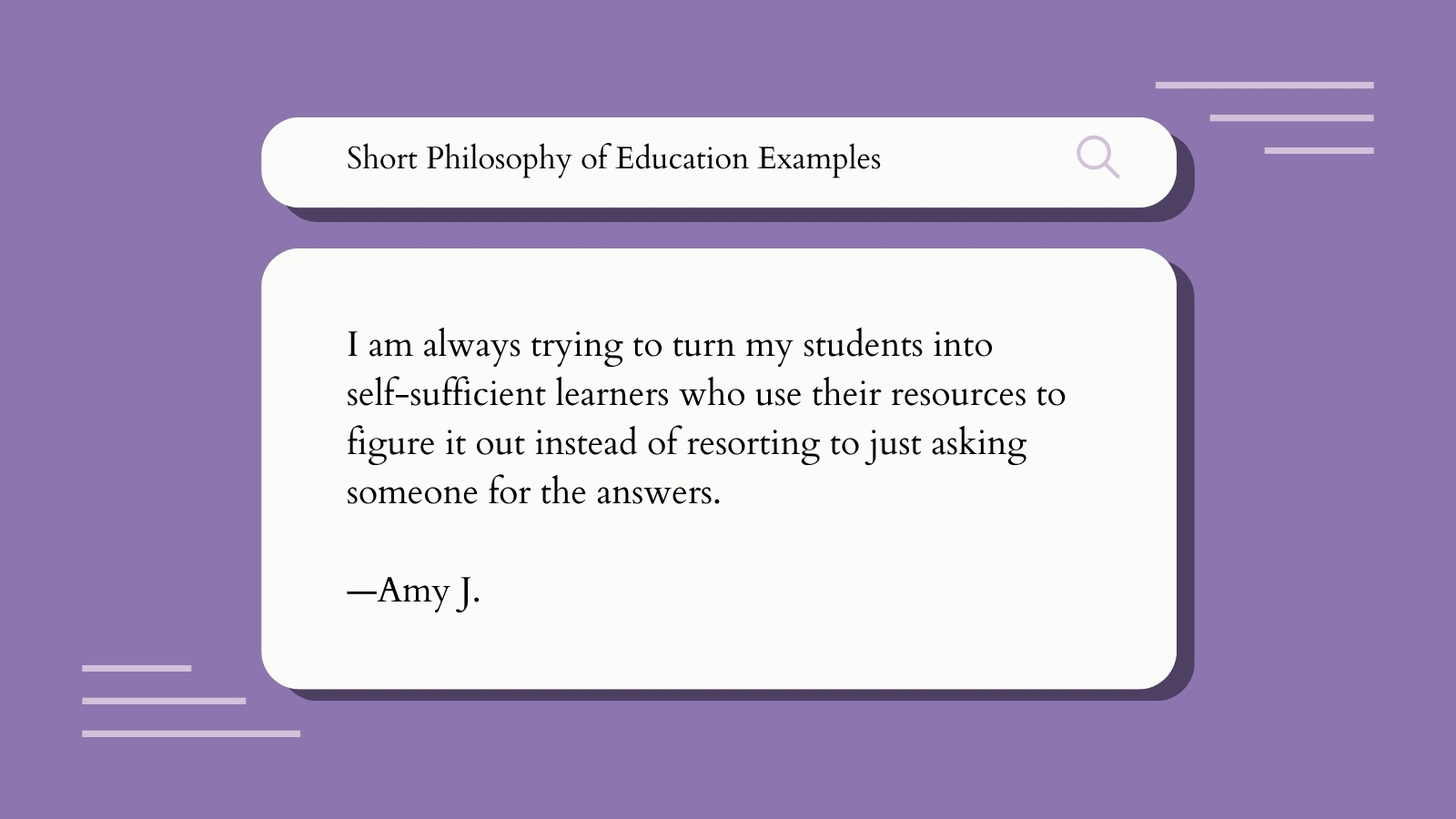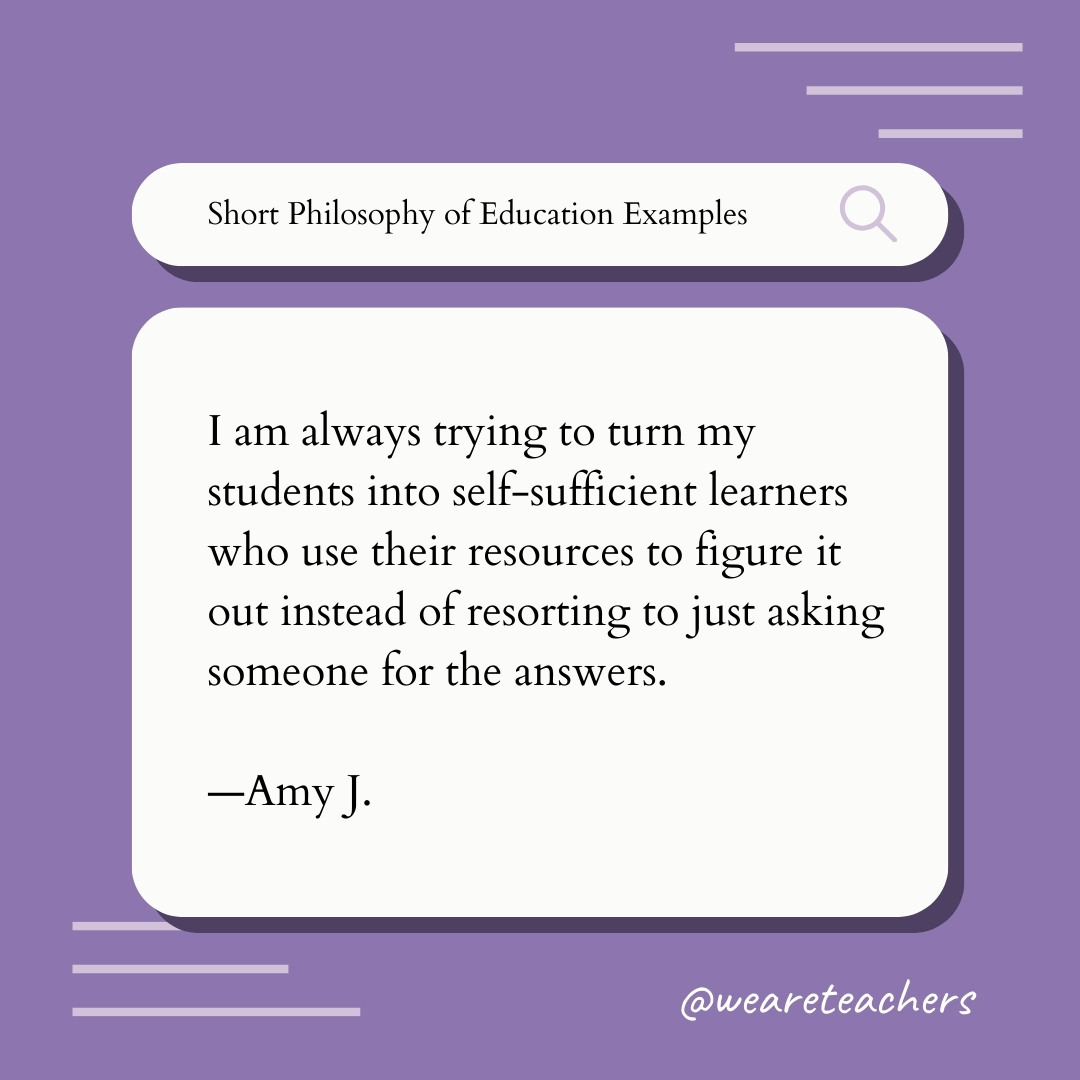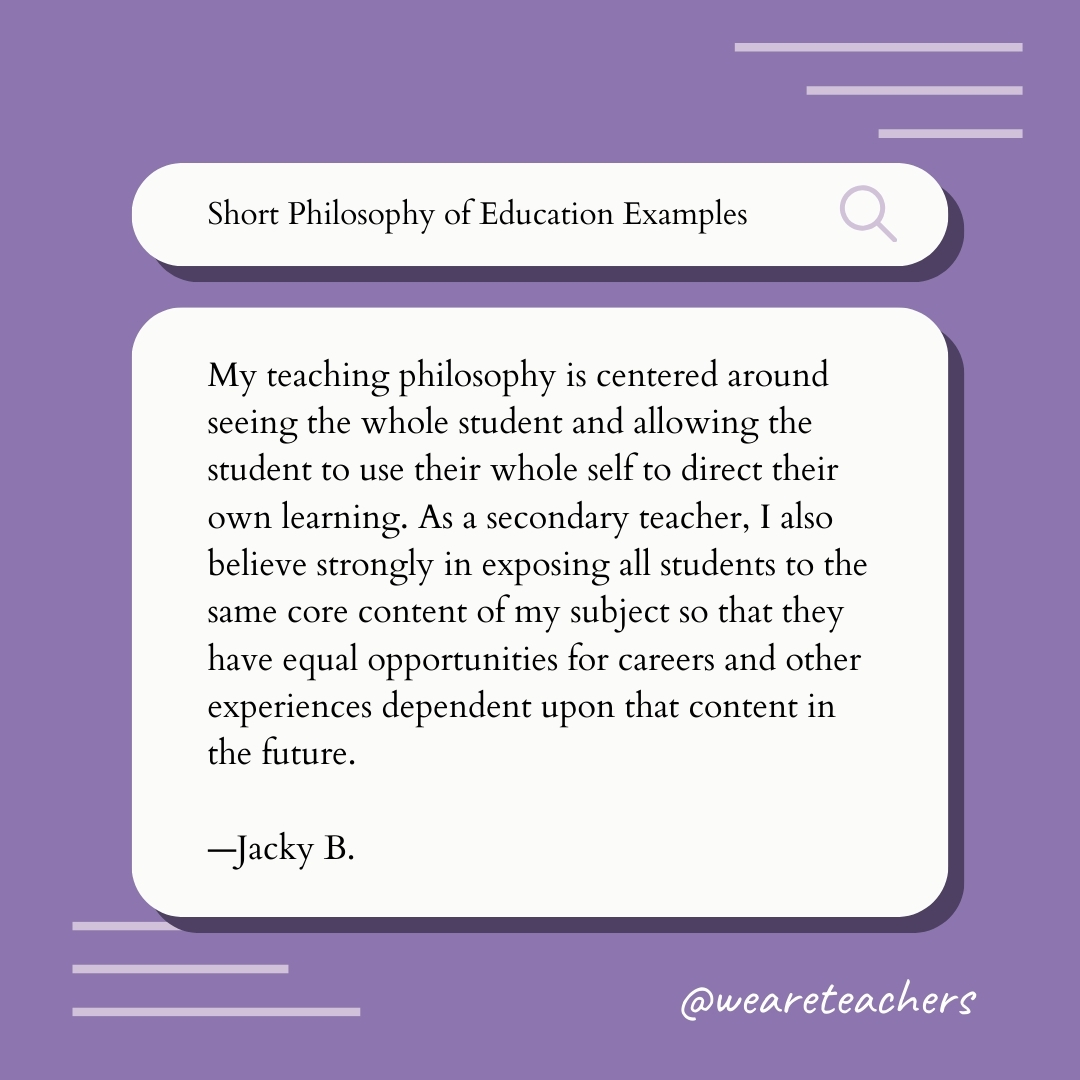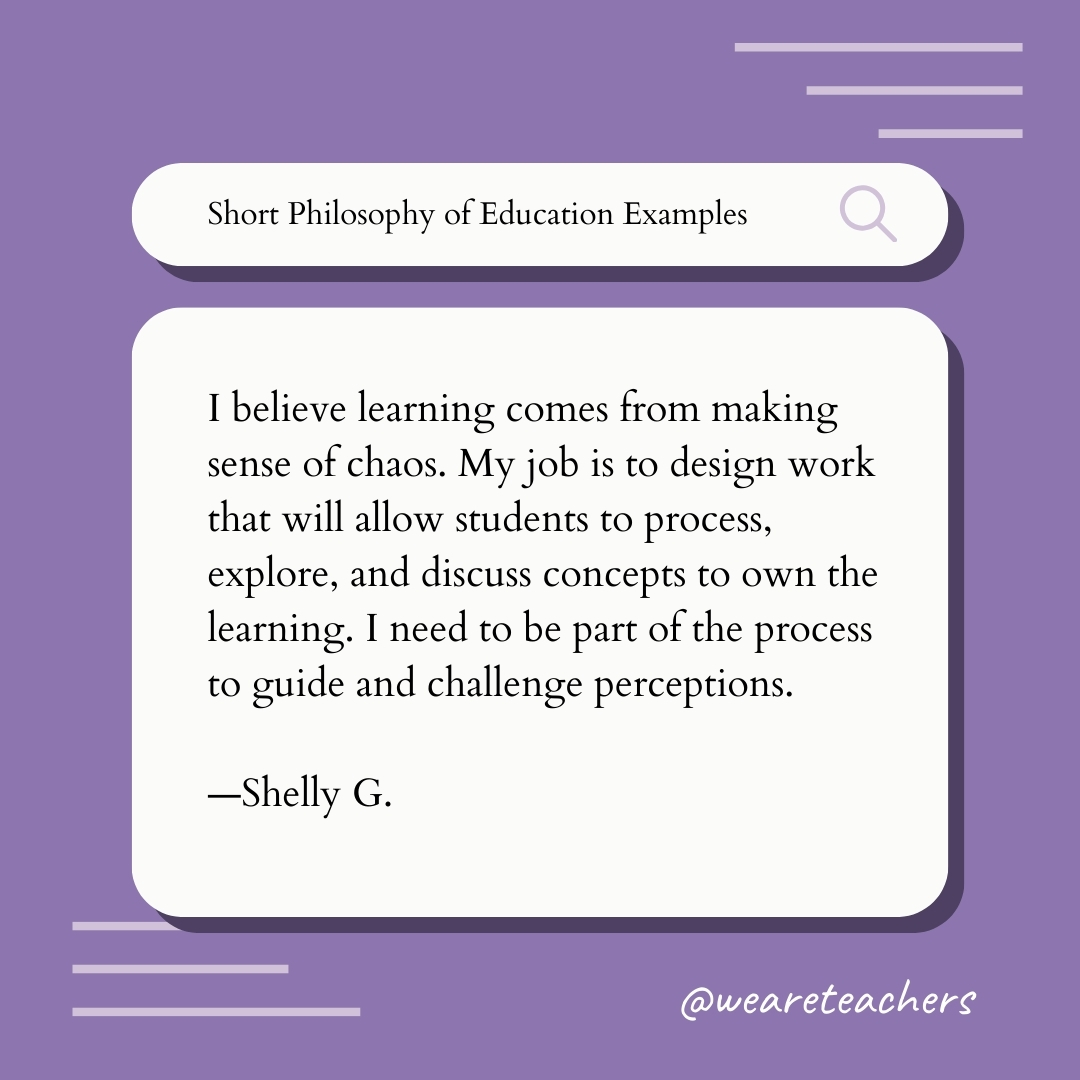
Learn how to define and share your teaching philosophy.

These days, it’s become common for educators to be asked what their personal teaching philosophy is. Whether it’s for a job interview, a college class, or to share with your principal, crafting a philosophy of education can seem like a daunting task. So set aside some time to consider your own teaching philosophy (we’ll walk you through it), and be sure to look at philosophy of education examples from others (we’ve got those too!).
Before we dive into the examples, it’s important to understand the purpose of a philosophy of education. This statement will provide an explanation of your teaching values and beliefs. Your teaching philosophy is ultimately a combination of the methods you studied in college and any professional experiences you’ve learned from since. It incorporates your own experiences (negative or positive) in education.
Many teachers have two versions of their teaching philosophy: a long form (a page or so of text) and a short form. The longer form is useful for job application cover letters or to include as part of your teacher portfolio. The short form distills the longer philosophy into a couple of succinct sentences that you can use to answer teacher job interview questions or even share with parents.
Here’s one key thing to remember: There’s no one right answer to “What’s your teaching philosophy?” Every teacher’s will be a little bit different, depending on their own teaching style, experiences, and expectations. And many teachers find that their philosophies change over time, as they learn and grow in their careers.
When someone asks for your philosophy of education, what they really want to know is that you’ve given thought to how you prepare lessons and interact with students in and out of the classroom. They’re interested in finding out what you expect from your students and from yourself, and how you’ll apply those expectations. And they want to hear examples of how you put your teaching philosophy into action.
Depending on who you ask, a philosophy of education statement can include a variety of values, beliefs, and information. As you build your own teaching philosophy statement, consider these aspects, and write down your answers to the questions.
What do you believe is the purpose of teaching and learning? Why does education matter to today’s children? How will time spent in your classroom help prepare them for the future?
Use your answers to draft the opening statement of your philosophy of education, like these:
Do you believe in student-led learning, or do you like to use the Socratic method instead? Is your classroom a place for quiet concentration or sociable collaboration? Do you focus on play-based learning, hands-on practice, debate and discussion, problem-solving, or project-based learning? All teachers use a mix of teaching practices and styles, of course, but there are some you’re likely more comfortable with than others. Possible examples:
Why is it important to recognize all learning styles? How do you accommodate different learning styles in your classroom? What are your beliefs on diversity, equity, and inclusion? How do you ensure every student in your classroom receives the same opportunities to learn? How do you expect students to behave, and how do you measure success?
ADVERTISEMENTSample teaching philosophy statements about students might sound like this:
Think back to any essay you’ve ever written and follow a similar format. Write in the present tense; your philosophy isn’t aspirational, it’s something you already live and follow. This is true even if you’re applying for your first teaching job. Your philosophy is informed by your student teaching, internships, and other teaching experiences.
Lead with your core beliefs about teaching and learning. These beliefs should be reflected throughout the rest of your teaching philosophy statement.
Then, explain your teaching style and practices, being sure to include concrete examples of how you put those practices into action. Transition into your beliefs about students and learning styles, with more examples. Explain why you believe in these teaching and learning styles, and how you’ve seen them work in your experiences.
A long-form philosophy of education statement usually takes a few paragraphs (not generally more than a page or two). From that long-form philosophy, highlight a few key statements and phrases and use them to sum up your teaching philosophy in a couple of well-crafted sentences for your short-form teaching philosophy.
Still feeling overwhelmed? Try answering these three key questions:
If you can answer those three questions, you can write your teaching philosophy!
We asked real educators in the We Are Teachers HELPLINE group on Facebook to share their teaching philosophy examples in a few sentences. Here’s what they had to say:

My philosophy is that all students can learn. Good educators meet all students’ differentiated learning needs to help all students meet their maximum learning potential. —Lisa B.
I believe that all students are unique and need a teacher that caters to their individual needs in a safe and stimulating environment. I want to create a classroom where students can flourish and explore to reach their full potential. My goal is also to create a warm, loving environment, so students feel safe to take risks and express themselves. —Valerie T.
In my classroom, I like to focus on the student-teacher relationships/one-on-one interactions. Flexibility is a must, and I’ve learned that you do the best you can with the students you have for however long you have them in your class. —Elizabeth Y
I want to prepare my students to be able to get along without me and take ownership of their learning. I have implemented a growth mindset. —Kirk H.

All children learn best when learning is hands-on. This works for the high students and the low students too, even the ones in between. I teach by creating experiences, not giving information. —Jessica R.
As teachers, it’s our job to foster creativity. In order to do that, it’s important for me to embrace the mistakes of my students, create a learning environment that allows them to feel comfortable enough to take chances, and try new methods. —Chelsie L.
I believe that every child can learn and deserves the best, well-trained teacher possible who has high expectations for them. I differentiate all my lessons and include all learning modalities. —Amy S.
All students can learn and want to learn. It is my job to meet them where they are and move them forward. —Holli A.
 My job is to design work that will allow students to process, explore, and discuss concepts to own the learning. I need to be part of the process to guide and challenge perceptions. —Shelly G." width="1080" height="1080" />
My job is to design work that will allow students to process, explore, and discuss concepts to own the learning. I need to be part of the process to guide and challenge perceptions. —Shelly G." width="1080" height="1080" />
I want my students to know that they are valued members of our classroom community, and I want to teach each of them what they need to continue to grow in my classroom. —Doreen G.
Teach to every child’s passion and encourage a joy for and love of education and school. —Iris B.
I believe in creating a classroom culture of learning through mistakes and overcoming obstacles through teamwork. —Jenn B.
It’s our job to introduce our kids to many, many different things and help them find what they excel in and what they don’t. Then nurture their excellence and help them figure out how to compensate for their problem areas. That way, they will become happy, successful adults. —Haley T.
Looking for longer teaching philosophy examples? Check out these selections from experienced teachers of all ages and grades.